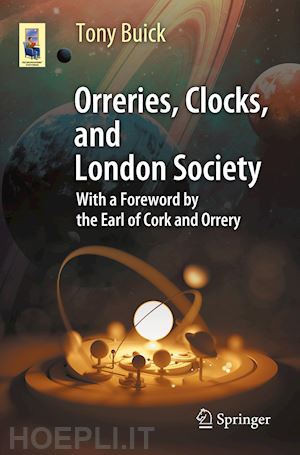
Questo prodotto usufruisce delle SPEDIZIONI GRATIS
selezionando l'opzione Corriere Veloce in fase di ordine.
Pagabile anche con Carta della cultura giovani e del merito, 18App Bonus Cultura e Carta del Docente
Orreries—mechanical models of the Solar System and its motions—are found everywhere. They appear in paintings, on computers, across natural landscapes, and in museums all over the world. The more you look, the more you find, yet their significance is often overlooked aside other great astronomical inventions.
This book reclaims the history of the orrery, offering a fascinating look into its evolution over the centuries. With a particular focus on London society and clockmakers, it weaves together historical narrative with practical know-hows and scientific fact, showing how the orrery changed from a fanciful toy to a high-tech instrument to a vessel for art and education.
The first edition, Orrery, explained what an orrery is and how it got its name. This revised edition goes several steps further, tracing the instrument back to the time of Ptolemy and forward to planetariums and star projectors. In addition, it features new sections on how to construct your own orrery at home.
This book will appeal to anybody interested in astronomical mechanical devices, scientific instruments, horology, or the history of clocks.
Chapter 1. Setting the Scene.- Chapter 2. Honest George, Chronometers and the Mystery of the Disappearing Proto-Orreries.- Chapter 3. Orrery: the Man and the Model.- Chapter 4. A Closer Look at Gear Calculations, Time Corrections, Escapements and Orbital Resonance.- Chapter 5. The Clockmaker’s London.- Chapter 6. Modern and Orrery Times Compared.- Chapter 7. The Planetarium: A Journey into Space.- Chapter 8. Postface.- Appendix 1: A Select Timeline.- Appendix 2: Glossary.- Appendix 3: Bibliograph.- Index
Dr. Tony Buick is a chemist by profession and a Fellow of the Royal Society of Chemistry. In the area of amateur astronomy, he has contributed to Sky at Night, MENSA, the Society for Popular Astronomy and various other magazines and journals. Upon his retirement, Dr. Buick returned to his lifelong interest in astronomy, prompting the research that forms the foundation of this book. He has a wide range of interests, from the infinite— through a telescope—to the infinitesimal—through a microscope—and has in addition to his astronomy work published articles on tardigrades, robust microscopic animals that can even survive in space.











Il sito utilizza cookie ed altri strumenti di tracciamento che raccolgono informazioni dal dispositivo dell’utente. Oltre ai cookie tecnici ed analitici aggregati, strettamente necessari per il funzionamento di questo sito web, previo consenso dell’utente possono essere installati cookie di profilazione e marketing e cookie dei social media. Cliccando su “Accetto tutti i cookie” saranno attivate tutte le categorie di cookie. Per accettare solo deterninate categorie di cookie, cliccare invece su “Impostazioni cookie”. Chiudendo il banner o continuando a navigare saranno installati solo cookie tecnici. Per maggiori dettagli, consultare la Cookie Policy.